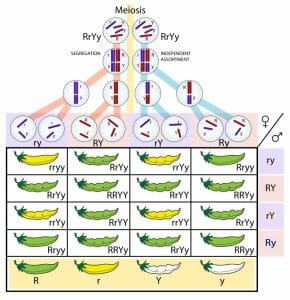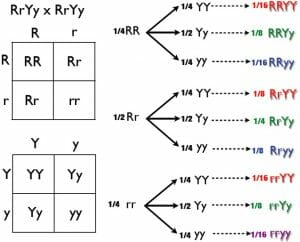Dihybrid Cross Definition
A dihybrid cross is an experiment in genetics in which the phenotypes of two genes are followed through the mating of individuals carrying multiple alleles at those gene loci. Most sexually reproducing organisms carry two copies of each gene, allowing them to carry two different alleles. Historically, an organism with parts from two different true-breeding lines was referred to as a “hybrid”. Thus, the name “dihybrid cross” comes from the historical act of observing the future generations after two “pure lines” are crossed. Today, we refer to organisms that are “true-breeding” for a certain gene as homozygotes. This refers to how the alleles used to form the zygote were the same. Heterozygous individuals, on the other hand, used two different alleles to form the zygote. A dihybrid cross, therefore, is the mating of two individuals, both heterozygous for two different genes being observed.
Examples of Dihybrid Cross
An important distinction must be made between dihybrid cross and mode of inheritance. While the dihybrid cross is typically thought of as an observations of two genes controlling two different phenotypic traits, both of which act under the complete dominance mode of inheritance. This is not always the case. The following examples show how the dihybrid cross can be used across different modes of inheritance.
A Classic Example with Complete Dominance
The classic model of a dihybrid cross is based in Mendelian genetics, so we will use Mendel’s peas for our example. See the image below. This image describes a dihybrid cross between two pea plants, looking at the traits of pod color and pod shape. The pods can be yellow or green, which is determined by the “R” gene. The “R” allele is dominant, and will cause the pod to be green in any plant where it is present. The “r” allele is recessive, and a genotype of “rr” will cause yellow pods. For pod shape, there are also two alleles present for the gene. The “Y” allele is dominant and causes wrinkled pods, whereas two “y” alleles cause a smooth shaped pod. The characters these alleles represent can be seen at the bottom of the chart, in the yellow box.
At the top of the chart are the gametes produced by the mother. The mother and father are both dihybrids, “RrYy”. This means that after the process of gametogenesis, they will have produced the same gametes. The two cells at the top of the chart represent two diploid cells, as they enter meiosis. The two pathways shown highlight how eight different combinations can be created with these two cells. The left pathway shows how individual alleles are segregated into their own gametes after being replicated during meiosis I, then separated during meiosis II. The right side pathway shows the same thing, with the additional rearrangement of the parental genes. This is known as independent assortment, and also accounts for the variety created by sexual reproduction.
At the end of this process, four different classes of gametes are created. They are: “ry”, “RY”, “rY”, and “Ry”, as listed on the top and sides of the chart. The Punnett square is completed, showing the offspring that this cross would produce. If you count the different types of offspring, you will notice that there are only a few types. There is 1 smooth, yellow plant. There are 3 wrinkled, yellow plants. There are 3 green, smooth plants. Lastly, there are 9 wrinkled, green plants. This dihybrid cross shows the typical 9:3:3:1 phenotypic ratio expected when the traits both show complete dominance and are independent of each other.
Other Modes of Inheritance
The above example is simple to understand, but remember that a dihybrid cross does not always yield a 9:3:3:1 phenotypic ratio. Any time the mode of inheritance in different, this ratio will be different. Consider the following diagram, which is known as the “tree method” for dihybrid crosses. In this method, the genotypic ratios of each different gamete are multiplied by the second gene to get the same results, just displayed vertically instead of in a square. Remember this method for faster math when trying to figure out the number of offspring that will carry a certain trait.
If these alleles represent the same alleles that we talked about on the pea plant, we could easily count which genotypes belong to which phenotypes, and we would find the 9:3:3:1 ratio. However, not all genes show complete dominance. Pretend that instead of only round or wrinkled, that the pea plant would produce an intermediate variety with the genotype “Yy”. This is known as incomplete dominance, and it will change the phenotypic ratios found. Now, everywhere there is “Yy” there is a new phenotype which we will call “half-wrinkled”. Count the new phenotypic ratio.
You should find that there are now 2 more phenotypes, yellow half-wrinkled and green half-wrinkled. There are 2 green wrinkled, 2 green half wrinkled, 2 green round, 1 yellow wrinkled, 1 yellow half-wrinkled, and 1 yellow round. In other terms, the new phenotypic ratio is 2:2:2:1:1:1. You can see how things can begin to get complicated when different modes of inheritance are involved. Many other modes of inheritance are possible, and multiple genes can control a single trait. Further, there are often many more than 2 alleles in a population. While the principles are the same, scientist start to use computers to analyze a complex dihybrid cross, and can even increase the number of genes looked at. This is called a polyhybrid cross, and you would need a much larger Punnett square to work it out.
Quiz
1. You are a scientist studying fruit flies. You want to test the theory of the dihybrid cross on your flies. Where do you begin?
A. Breed two hybrid flies together
B. Establish lines of homozygotes
C. Count the number of each type of fly you have
2. You now have you two lines of flies, which are homozygotes for two different traits. However, you don’t know the mode of inheritance for the genes you are testing. What will be your first clue?
A. The phenotypic ratio of the offspring
B. The phenotypes of the dihybrids
C. The genotypic ratio of the dihybrids
3. You are breeding two organisms from a population. The population has three different alleles for the two genes you are observing. All the alleles are codominant. One has the genotype “P1P2S1S2” while the other has the genotype “P2P3S2S3”. Is this a dihybrid cross?
A. Yes
B. No
C. Only if one allele is most dominant
Reference
- Hartwell, L. H., Hood, L., Goldberg, M. L., Reynolds, A. E., & Silver, L. M. (2011). Genetics: From Genes to Genomes. Boston: McGraw Hill.
Dihybrid Cross


No comments:
Post a Comment